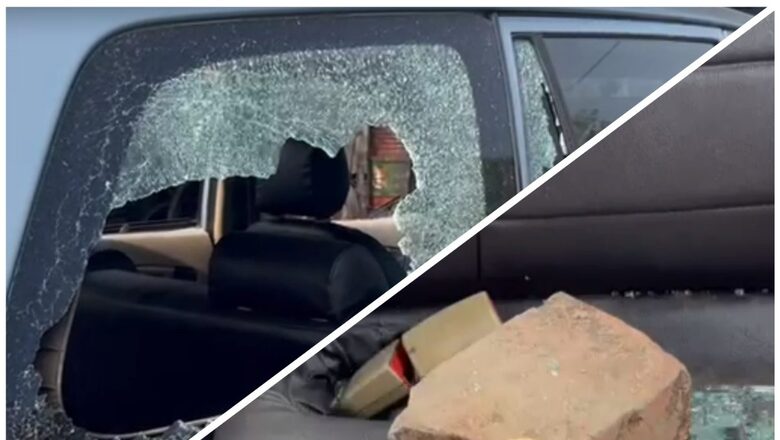
views
Three sadhus (saints) were allegedly thrashed by an irate mob in a far-flung village in West Bengal’s Purulia district. Video clips of the incident that went viral on social media showed the sadhus being stripped and assaulted by a strong mob. Following a political slugfest, the ruling Trinamool Congress (TMC) issued a statement, as did the West Bengal Police, stating that they were mistaken as “kidnappers" by locals, however, police reached the spot, rescued them and arrested 12 persons.
A week ago, two senior officers of the Enforcement Directorate (ED), including an officer of assistant director rank, in Bengal’s North 24 Parganas district were critically injured while they were on their way to raid a local TMC leader’s house. They were attacked by a mob of thousands, armed with stones and sticks. The vehicle was ransacked, and the officers and accompanying security personnel were assaulted.
The causes of the incidents, which happened in a span of seven days, were different, but the nature was the same. Both were incidents of mob violence.
Political parties, be it the ruling or the Opposition in West Bengal, a state that has a history of mob violence, seem to have normalised such incidents, calling them “public outrage" or “spontaneous public resistance". “Such action by political parties leads to ‘impunity’," said a senior IPS officer who served as a DG in the state and saw such incidents happening across the Left Front and Trinamool Congress rule.
Last week, minutes after the officers of the ED and central forces were attacked, senior politicians, including cabinet ministers, came up with statements saying that the incident was a consequence of “provocation" and it was nothing, but “public outrage". First Information Reports (FIR) were filed against the officers, while another FIR was filed against “unknown persons" reportedly under bailable sections for violence.
This has been a trend.
There are dozens of video clips of senior politicians, including the chief minister of the state, her cabinet colleagues, senior MPs “instigating" the public by directing them to “build resistance if police come". There are public statements of senior leaders saying that the public should attack police — state or central — if there is an administrative excess. And it is not only for the central forces or agencies, the state police, its officers and personnel, were assaulted, thrashed, killed by the members of ruling and Opposition parties several times. However, the politicians never change their style of speaking.
MOB VIOLENCE, LYNCHING, RIOTING: PERPETRATORS ARE ALWAYS ‘UNKNOWN’
Is mob violence always a result of “public outrage" or a reflection of “frustration"? The records with the governments and the politics of the state will speak otherwise. Under the Congress, Left and TMC rule, West Bengal has witnessed brutal instances of mob violence. However, people hardly remember any remedial action or perpetrators being penalised for their crime.
In March 1970, a family of Congress supporters in Burdwan was hacked and chopped to death allegedly by a mob led by senior members of rival political party CPM. The perpetrators, at least the ones named by several witnesses, were never brought to justice. Instead, they rose up the ranks to become ministers in the state cabinets, MPs and MLAs. The incident is known as Saibari Killings.
In April 1982, a group of 17 sadhus belonging to a Hindu cult group – Ananda Marga – was assaulted by mob in south Kolkata and burnt to death inside a van carrying them. A leading daily of Kolkata reported the incident as – “Seventeen Ananda Margis, two of them women, were killed on April 30 morning by frenzied mobs… on the suspicion that they were child-lifters". The government termed it a “public outrage" orchestrated to “embarrass the ruling party before the elections". This incident is called the ‘Anandamargi Massacre’.
In the recent past, post the 2021 election results, around 40 members of the ruling TMC and the Opposition BJP, Congress and CPM were lynched. The violence and lynching happened over a span of four to five days in the state just after the results were out. The violence was the result of political rivalry and retaliation. In almost every case, the victim was dragged out of their house and lynched by hundreds. The administration almost disappeared as the violence continued unabated until there was an outrage. The Central Bureau of Investigation (CBI) took over the 52 cases of violence. The investigation is still pending.
States such as Jharkhand, Rajasthan, Bihar and Uttar Pradesh, too, have witnessed such incidents over allegations of carrying beef, smuggling cattle or practising witch craft.
MANAGING MOB, CONTROLLING VIOLENCE
The Bharatiya Nyaya Sanhita (BNS), which was passed in Parliament to replace the Indian Penal Code (IPC), addresses cases when a mob of five or more individuals commits murder based on factors such as race, caste, community or personal belief.
According to section 101 of the BNS, “When a group of five or more persons acting in concert commits murder on the ground of race, caste or community, sex, place of birth, language, personal belief or any other ground each member of such group shall be punished with death or with imprisonment for life or imprisonment for a term which shall not be less than seven years, and shall also be liable to fine."
Even though the state governments or the National Crime Record Bureau (NCRB) do not record such cases of mob violence or lynching as a category, senior IPS officers serving in the NCRB or in the government say the category of ‘rioting’ or ‘offences against public tranquility’ include incidents of mob violence. According to the data published in 2022-2023, a total of 57,082 cases of offences against public tranquility were registered under various sections of IPC during 2022, of which rioting (37,816 cases) accounted for 66.2%.
A senior IPS officer serving in the MHA said the issue of mob violence was discussed in several crime conferences, including the DGP conference with the Prime Minister. “Police forces have been asked to carry out awareness campaigns, start patrolling in localities far away from the police stations, and set an example by penalising the perpetrators. However, in most cases, the trails go cold due to political patronage," said the senior officer.
Another senior police officer said that senior politicians have a crucial role in minimising the scope of such instances. “Their speeches matter to the general public. The political parties that have presence at the ground level may intervene when these kinds of incidents are noticed, as police stations have their own limitations. The force also needs time to reach a certain location. But political parties, their Panchayat and block level offices are everywhere. They can be the first respondents, which hardly happens," he added.
















Comments
0 comment